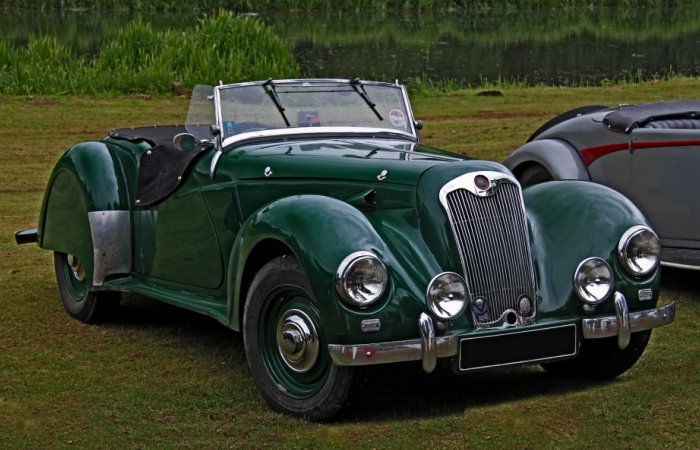Description
The Lea-Francis 12 Sports was one of the finest examples of British sporting motoring from the late 1930s, embodying a rare combination of mechanical sophistication, craftsmanship, and driver engagement. Built by the small but highly respected Coventry firm Lea-Francis, the 12 Sports was a car designed for the enthusiastic motorist who sought spirited performance and fine engineering without sacrificing refinement or durability. It was a genuine driver’s car at a time when most British sports models were either stripped-down racers or softly tuned tourers, and it helped cement Lea-Francis’s reputation for producing some of the most accomplished sporting cars of the pre-war era.
At its heart, the 12 Sports used Lea-Francis’s proven 1.5-litre four-cylinder engine, a robust overhead-valve unit developed in partnership with the renowned engine specialist Meadows. Displacing 1,496 cc and equipped with twin SU carburettors, the engine produced between 45 and 50 horsepower—figures that, while modest by modern standards, were impressive for a light sports car in the mid-1930s. With its free-revving nature and excellent torque delivery, the engine gave the 12 Sports lively acceleration and a top speed of around 75 mph (120 km/h), making it more than a match for contemporary MGs, Singers, and Rileys.
The power was transmitted through a precise four-speed manual gearbox, with synchromesh on the upper gears in later models. The gearbox was operated by a short, positive lever positioned close to the driver’s hand, contributing to the car’s engaging, mechanical feel. The rear-wheel-drive layout, combined with a well-balanced chassis and relatively light weight, endowed the 12 Sports with agile handling and excellent road manners. The suspension featured semi-elliptic leaf springs and hydraulic dampers, while the braking system used mechanically operated drums on all four wheels, well known for their reliability and progressive response.
The chassis was one of the 12 Sports’ greatest strengths. Lea-Francis engineers paid careful attention to rigidity and weight distribution, producing a frame that offered both strength and responsiveness. This gave the car a sense of precision that few contemporaries could match, particularly in fast cornering, where its steering accuracy and composure stood out. It was a car that could be driven hard with confidence—quick, predictable, and immensely rewarding on winding country roads.
Visually, the Lea-Francis 12 Sports was an elegant expression of pre-war British design. The most popular version featured a two-seater open tourer body with sweeping front wings, a long bonnet, and a neatly tapered tail. Many examples were bodied by specialist coachbuilders such as Abbey Coachworks and Vulcan, resulting in subtle variations in detail and style, though all shared the same classic proportions and low, rakish stance. The front grille was tall and narrow, crowned by the Lea-Francis emblem, while large chromed headlamps and twin horns gave the car a purposeful yet distinguished appearance. Wire-spoked wheels and a rear-mounted spare completed the quintessential 1930s sports car aesthetic.
The interior was simple but well finished, reflecting Lea-Francis’s attention to quality. The cockpit was trimmed in leather, with bucket-style seats, a polished wooden dashboard, and an array of Smiths instruments providing oil pressure, water temperature, and speed readings. The driving position was low and intimate, the long bonnet stretching ahead of the driver’s view, while the folding windscreen could be lowered for open-air motoring at speed. Everything about the car’s layout emphasized direct engagement between driver and machine—an ethos that would become a hallmark of the brand.
On the road, the 12 Sports delivered a driving experience that was both spirited and civilized. Its compact dimensions, excellent steering feedback, and smooth power delivery made it ideally suited to Britain’s narrow, twisting roads. The car’s balance and responsiveness allowed skilled drivers to extract impressive pace, yet it remained comfortable and tractable for touring. The exhaust note—crisp, purposeful, and unmistakably mechanical—added to the sense of character that made the 12 Sports so rewarding to drive. It was not a car built for raw speed, but for the pleasure of motoring with precision and style.
Lea-Francis offered the 12 Sports in both two- and four-seater configurations, with a small number of fixed-head coupé versions also produced. Each car was built largely by hand, ensuring a level of craftsmanship uncommon in cars of its class. Buyers could specify various options, including paint colours, trim finishes, and sporting accessories such as spotlights or luggage racks. The company’s emphasis on bespoke quality and mechanical excellence attracted a discerning clientele who appreciated individuality over mass production.
Production of the Lea-Francis 12 Sports continued until the outbreak of the Second World War in 1939, which brought an end to civilian car manufacturing in Britain. In total, only a few hundred examples were produced, making surviving cars today both rare and highly prized among collectors.
The 12 Sports occupies a special place in British motoring history. It represented the ideal balance between refinement and performance—a car equally at home in long-distance touring as it was on the winding roads of the Lake District or the Welsh hills. It reflected the best of 1930s design philosophy: light, responsive, beautifully engineered, and crafted with care.
Today, the Lea-Francis 12 Sports stands as a symbol of an era when driving was an art form and cars were built with passion and individuality. Well-preserved examples are admired not just for their elegance but for their ability to deliver a genuinely engaging and rewarding experience more than eight decades after they were made. It remains a reminder of how a small Coventry manufacturer managed to create one of the finest British sports cars of its time—charming, capable, and deeply authentic.

